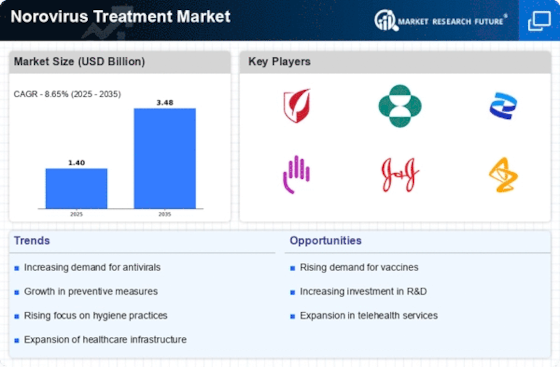Rising Incidence of Norovirus Infections
The increasing incidence of norovirus infections is a primary driver for the Norovirus Treatment Market. According to health authorities, norovirus is responsible for a significant percentage of gastroenteritis cases worldwide, leading to millions of infections annually. This surge in cases necessitates effective treatment options, thereby propelling market growth. The economic burden associated with norovirus outbreaks, including healthcare costs and lost productivity, further emphasizes the need for innovative treatment solutions. As awareness of norovirus's impact on public health grows, healthcare providers and pharmaceutical companies are likely to invest more in research and development, aiming to enhance treatment efficacy and accessibility. Consequently, the rising incidence of norovirus infections is expected to stimulate demand within the Norovirus Treatment Market.
Emerging Technologies in Treatment Development
Emerging technologies in treatment development are reshaping the landscape of the Norovirus Treatment Market. Innovations such as monoclonal antibodies and advanced antiviral agents are being explored to combat norovirus effectively. These technologies offer the potential for more targeted and efficient treatment options, which could significantly improve patient outcomes. The integration of biotechnology in drug development is particularly promising, as it allows for the creation of therapies that can specifically inhibit norovirus replication. As these technologies advance, they are likely to attract investment and interest from pharmaceutical companies, further stimulating market growth. The emergence of these novel treatment modalities could redefine standards of care within the Norovirus Treatment Market.
Increased Investment in Research and Development
Investment in research and development is a crucial driver for the Norovirus Treatment Market. Pharmaceutical companies are increasingly allocating resources to develop novel antiviral therapies and vaccines targeting norovirus. This trend is supported by the recognition of norovirus as a significant public health concern, prompting both private and public entities to fund research initiatives. Recent data indicates that the global market for antiviral drugs is projected to grow substantially, with a notable portion dedicated to norovirus treatments. The potential for lucrative returns on investment in this sector encourages innovation and competition among companies. As a result, the heightened focus on R&D is likely to lead to the introduction of more effective treatment options, thereby expanding the Norovirus Treatment Market.
Regulatory Support for Norovirus Treatment Initiatives
Regulatory support for norovirus treatment initiatives plays a pivotal role in shaping the Norovirus Treatment Market. Government agencies are increasingly recognizing the need for effective treatments and are streamlining approval processes for new therapies. This regulatory environment encourages pharmaceutical companies to invest in the development of innovative solutions for norovirus. Recent initiatives aimed at expediting the review of antiviral drugs and vaccines have the potential to bring new treatments to market more rapidly. Additionally, collaboration between regulatory bodies and industry stakeholders fosters an ecosystem conducive to innovation. As a result, the supportive regulatory landscape is likely to enhance the availability of effective treatments, thereby driving growth in the Norovirus Treatment Market.
Growing Awareness of Norovirus Prevention and Treatment
The growing awareness of norovirus prevention and treatment is significantly influencing the Norovirus Treatment Market. Public health campaigns and educational initiatives have increased knowledge about the transmission and symptoms of norovirus, leading to heightened demand for effective treatments. As individuals become more informed about the risks associated with norovirus, they are more likely to seek medical attention and treatment options. This trend is reflected in the rising sales of over-the-counter medications and healthcare services related to norovirus. Furthermore, healthcare providers are increasingly emphasizing the importance of timely treatment to mitigate the severity of symptoms. Consequently, the enhanced awareness surrounding norovirus is expected to drive growth in the Norovirus Treatment Market.

















Leave a Comment